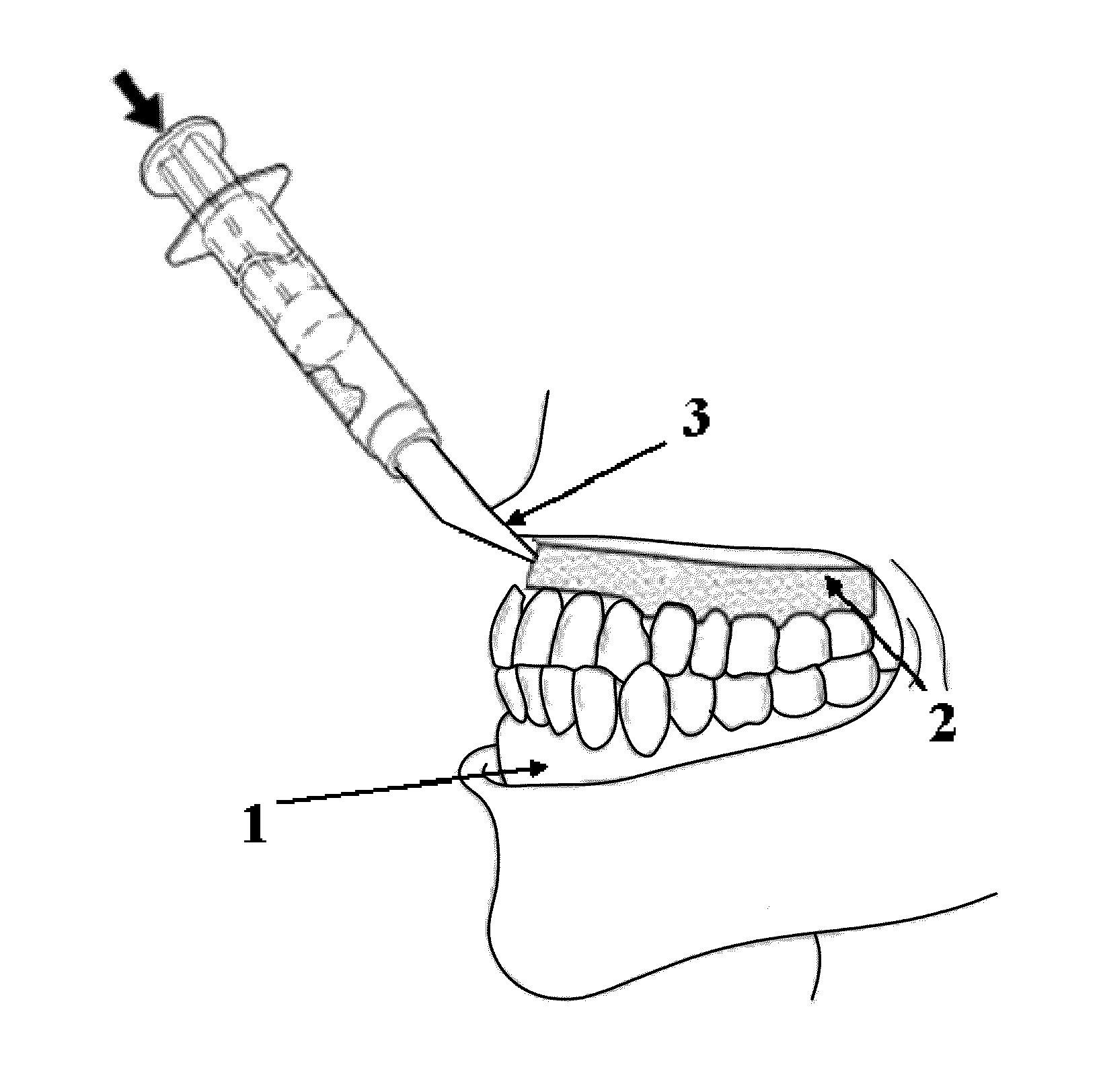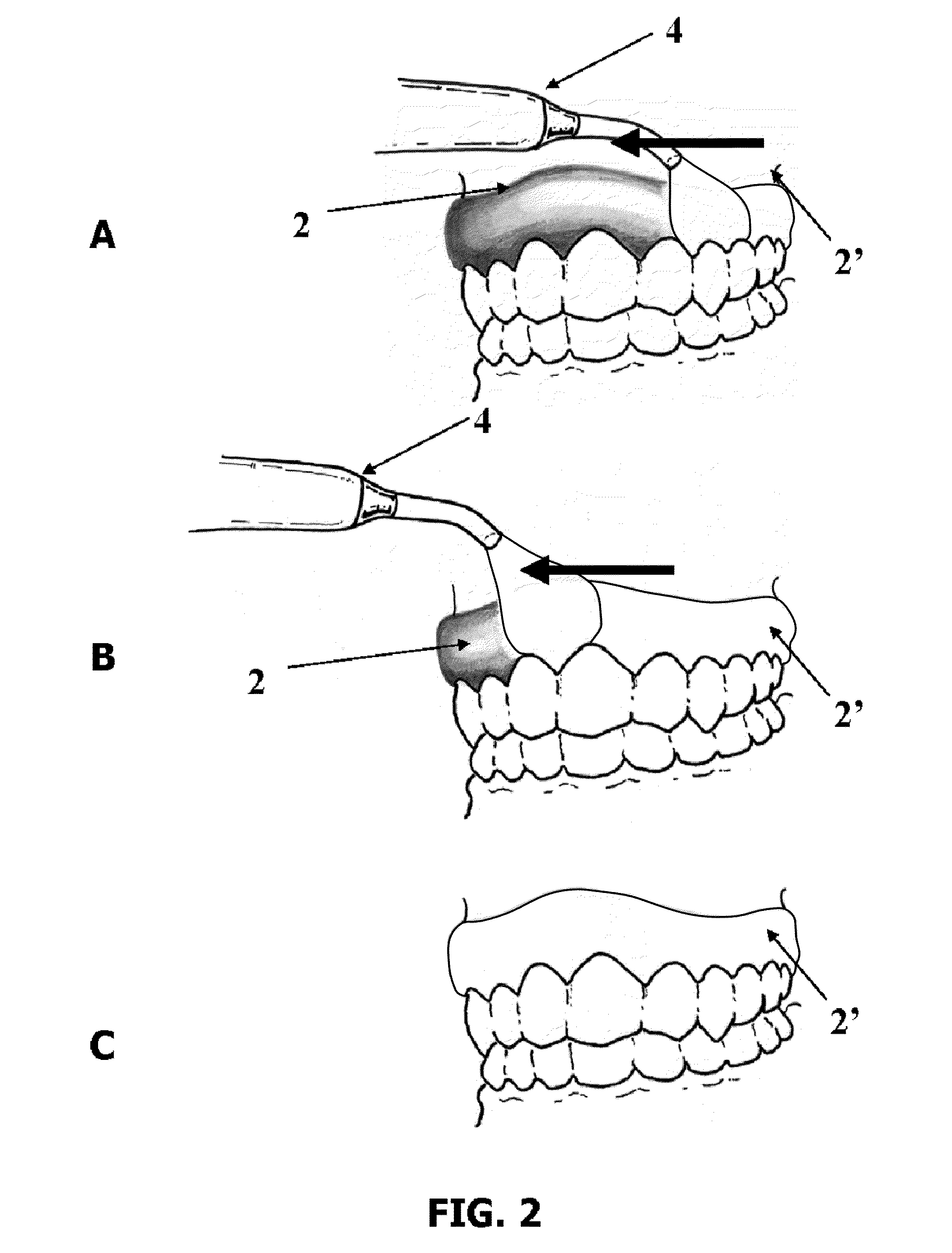Composition for dental barrier comprising at least one monomer, at least one polymerization initiating system, and at least one indicator enabling the polymerization reaction to be monitored
a technology of polymerization initiating system and dental barrier, which is applied in the field of dental barrier composition, can solve the problems of not being able to maintain the dental barrier properly, limiting the discomfort of patients, and risk of leaving certain areas unpolymerized, and achieves the protection of all tissues. , the effect of less cost and simple structur
- Summary
- Abstract
- Description
- Claims
- Application Information
AI Technical Summary
Benefits of technology
Problems solved by technology
Method used
Image
Examples
example 1
Composition A According to the Invention
[0072]A composition is prepared comprising:
Productwt. %Diurethane dimethacrylate42.0%Triethylene glycol dimethacrylate42.0%Camphorquinone0.4%Ethyl-4-dimethylaminobenzoate0.4%Aerosil 200 ®15.1%Methylene blue0.1%
[0073]Here, diurethane dimethacrylate and triethylene glycol dimethacrylate are the monomers that constitute the copolymer.
[0074]The combination of camphorquinone and ethyl-4-dimethylaminobenzoate is able to initiate polymerization after exposure to a dental lamp emitting blue light of wavelength between 420 and 480 nm. This polymerization is responsible for adhesion to an organic substrate, for example a buccal tissue.
[0075]Ethyl-4-dimethylaminobenzoate is also able to absorb UV-A.
[0076]Aerosil 200®, which is an anhydrous colloidal silica, is used in the present invention in order to thicken the medium and promote its stability at rest, on account of its thixotropy.
[0077]Methylene blue acts as an indicator of polymerization, by its colo...
example 2
Composition B According to the Invention
[0078]A composition is prepared comprising:
Productwt. %Diurethane dimethacrylate59.0%Triethylene glycol dimethacrylate 25%Camphorquinone 0.4%Ethyl-4-dimethylaminobenzoate 0.4%Aerosil ®15.1%Bromophenol blue 0.1%
[0079]Same remarks as for composition A according to the invention.
[0080]Here, the bromophenol blue indicates polymerization by its color change.
example 3
Composition C According to the Invention
[0081]A composition is prepared comprising:
Productwt. %Bisphenol A dimethacrylate54.0%Triethylene glycol dimethacrylate30.0%Lucirin ® TPO0.8%Ethoxylated ethyl-4-aminobenzoate5.0%Aerosil 400 ®10.0%Methyl red0.2%
[0082]Here, bisphenol A dimethacrylate and triethylene glycol dimethacrylate are the monomers that constitute the copolymer.
[0083]Lucirin® TPO, which is 2,4,6-trimethylbenzoyldiphenylphosphine oxide, is able to initiate polymerization after exposure to a dental lamp emitting blue light of wavelength between 420 and 460 nm. This polymerization is responsible for the adhesion to an organic substrate, for example a buccal tissue.
[0084]Ethoxylated ethyl-4-aminobenzoate absorbs UV-A.
[0085]Aerosil 400®, which is a colloidal silica, is used in the present invention to thicken the medium.
[0086]Methyl red indicates polymerization by its color change.
PUM
| Property | Measurement | Unit |
|---|---|---|
| wavelength | aaaaa | aaaaa |
| wavelength | aaaaa | aaaaa |
| wavelength | aaaaa | aaaaa |
Abstract
Description
Claims
Application Information
 Login to View More
Login to View More - R&D
- Intellectual Property
- Life Sciences
- Materials
- Tech Scout
- Unparalleled Data Quality
- Higher Quality Content
- 60% Fewer Hallucinations
Browse by: Latest US Patents, China's latest patents, Technical Efficacy Thesaurus, Application Domain, Technology Topic, Popular Technical Reports.
© 2025 PatSnap. All rights reserved.Legal|Privacy policy|Modern Slavery Act Transparency Statement|Sitemap|About US| Contact US: help@patsnap.com



